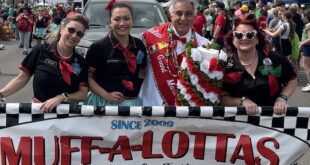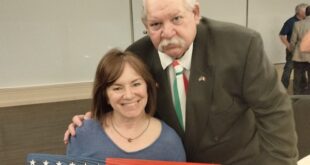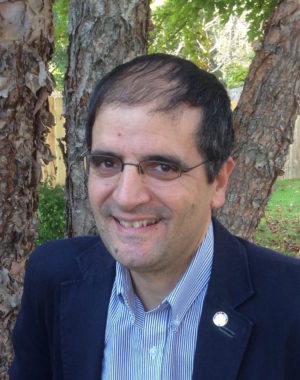 By bringing stories of Calabrian-American bravery to light, he is adding chapters to our history that would otherwise have been lost.
By bringing stories of Calabrian-American bravery to light, he is adding chapters to our history that would otherwise have been lost.
The saying “history is written by the winners” typically applies to military forces that dominate and subjugate, but one person has turned that notion on its head in the most positive sense. In his painstaking research into long gone Calabrian-American veterans, Peter Belmonte has achieved a victory for scores of humble heroes whose stories would otherwise have been lost in the trenches of World War I.
Why do this? It helps that Belmonte is a retired U.S. Air Force major of Calabrian lineage. But the work didn’t begin as a military or academic exercise; rather, it captivated him from the start.
The herculean task he has set for himself is rooted in the painstaking documentation of his own family’s ancestry that he began as an adolescent. Belmonte spoke with Lou&A about the nature and depth of his work, why it matters, and how his Italian roots inform and enrich it.
Lou&A: Tell us about your family background. You’ve done a very impressive job of researching it.
Peter Belmonte: I’m 100 percent Calabrian as far back as I can trace it. I’ve always been interested in history, in particular American history and military history. In my 8th grade history class, we had an assignment to draw up our family tree. By asking my parents and grandmother, and some of my aunts and uncles, I was able to trace my tree back to my great-grandparents and maybe one or two great-great-grandparents. I saw some of the family trees of other kids, some of them extended clear across the page, going for generations. I wanted to do that, too.
Later in life, I was able to view the microfilmed records of Marano Marchesato, the village most of my ancestors came from. I was able, through a lot of effort, strain, frustration and tears, to trace my family back to the early 1800s and late 1700s.
Lou&A: How did your family life impact you personally and professionally?
PB: Family and extended family were very important to me growing up. My grandmother lived in our house and we regularly visited grandparents, aunts, uncles and cousins. I learned to understand the Calabrian dialect at an early age, although I never did master speaking it. Listening to tales about the “old country” was fascinating for me. I only wish I had asked about what it was like to come to the U.S. and work on the railroads during the early 1900s, as my grandfathers had done.
Lou&A: All of this fascination with family history seems to lead to where you are today with your work. Tell us about that.
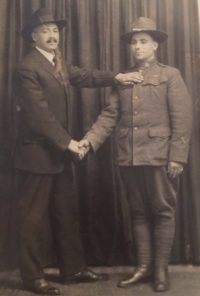
Carmine home from the war in early 1919.
PB: I’ve written mostly about military and immigration history. Fortunately, I can sometimes combine these topics. I have a book coming out in July, with co-author Alexander Barnes, “Forgotten Soldiers of World War I: America’s Immigrant Doughboys” (Schiffer Publishing). Plus my current work on Calabrian immigrants in the U.S. military during World War I — that’s my focus and passion right now.
Lou&A: How did your research process begin? Take us to the moment the light bulb went off.
PB: In the late 1800s and early 1900s, the various branches of my family came to the U.S. and settled in Chicago; Lake County, Illinois; and Kenosha, Wisconsin. In the mid-1990s, I went to the Simmons Library in Kenosha to conduct some research. Upon entering, I found that their vestibule is beautifully decorated with the names of all the men from Kenosha who’d served in World War I etched into the marble walls. Looking at this monument, I identified at least 50 men with names that originated in my family’s Calabrian area. Furthermore, I identified at least two men who were related to me, cousins of my grandparents.
Lou&A: Explain how you zeroed in on the villages of Marano Marchesato and Marano Principato, and the Cosenza area, for your two volumes of “Calabrian Americans in the U.S. Military During World War I.”
PB: As I researched further, I dug up more information; I then expanded to try to find men who settled in other areas, most notably in Chicago. After 20 years, I identified and collected information on 140 men from two villages who served in the U.S. military during World War I. I then determined to write about these men, as a historical record and as a tribute.
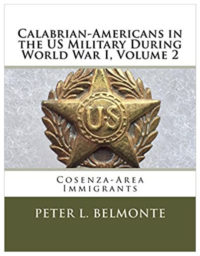 Lou&A: We’ve discussed your formidable research — what about these servicemen sprang to life as you sifted through the records?
Lou&A: We’ve discussed your formidable research — what about these servicemen sprang to life as you sifted through the records?
PB: What’s touched me so far is the fact that many of these men were drafted in the spring and summer of 1918. In many cases, they had absolutely minimal training before being sent overseas. Sometimes the men were transferred between several camps, never really having time to fit in or to properly train, before being sent to France.
There, some of the men were sent as replacements to combat units, again with minimal training and with almost no time to fit into a tightly-knit unit of men who had already established a bond based upon their combat experiences, where they learned how to depend upon each other. Then, these new men were quickly thrown into combat in the St. Mihiel or Meuse-Argonne offensives.
Lou&A: What major challenges have you encountered in this work?
PB: It can be difficult and frustrating to find evidence of military service for some men. Many men, no doubt, were killed in action and then disappeared from the historical record. Others returned to Italy shortly after the war and they, too, tend to vanish from the documents available to us. So I’ve established contact with the relatives of some of these men, and some have been very gracious in sending me photographs and other information. I’ve gotten permission to use these items in my books, and I like to think that I’ve helped in some small way to preserve and memorialize them.
Lou&A: Most of us think of World War II as the “Italian-American War,” but our service during World War I was significant, too, right?
PB: About 300,000, perhaps more, Italian Americans served in the U.S. military during World War I. That’s almost certainly the largest number from any single immigrant group — and their story hasn’t yet been told. Most of them either were unable or unwilling to put their experiences down on paper. You can find them mentioned in unit histories, rosters, et cetera, but nowhere is there an in-depth study of these men.
I intend to fill a gap with these books. By recording the service history of some of these men, I’m giving them recognition for their sacrifices and service.
To learn more about Peter Belmonte’s research and purchase his books, visit amazon.com and enter the name Peter L. Belmonte.
The above appeared in the March issue of the print version of Fra Noi. Our gorgeous, monthly magazine contains a veritable feast of news and views, profiles and features, entertainment and culture. To subscribe, click here.
 Fra Noi Embrace Your Inner Italian
Fra Noi Embrace Your Inner Italian


